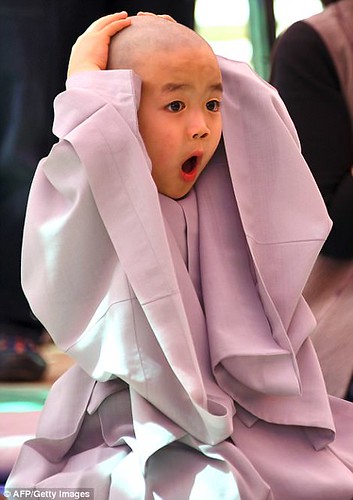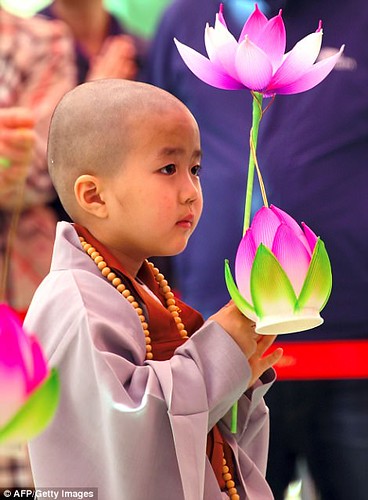NEWS
Eight Boys Ordained as Monks in Seoul Ahead of Celebrations to Mark Buddha’s Birthday
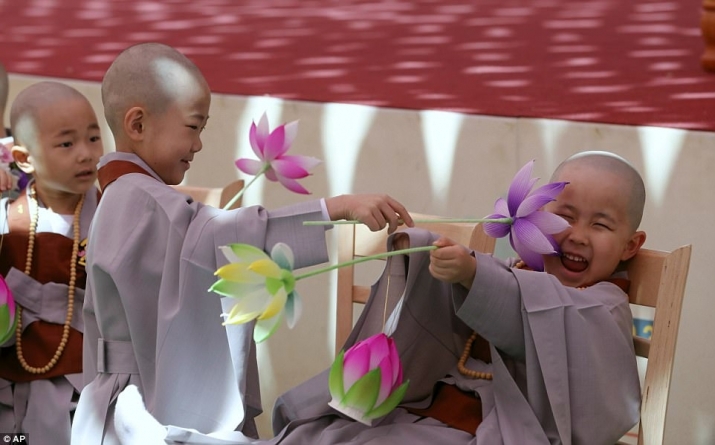 The boy monks playing with lotus lanterns. From mailonline.com
The boy monks playing with lotus lanterns. From mailonline.comIn preparation for celebrations in South Korea to mark the birth of the Buddha—this year observed on 3 May—eight boys, aged 5–7, were temporarily ordained in a traditional Buddhist ceremony at Jogye Temple in Seoul.
As part of the proceedings, the eight child monks—Bonyeon, Cheongan, Cheonghyu, Damun, Daseon, Jeongyeon, Seongyeon, and Seonhoe—who had joined Jogyesa’s “Bodhi Tree Sapling School: Children Becoming Buddhist Monks” program, had their heads shaven, causing mixed reactions among the boys.
The boy monks were also dressed in traditional grey monastic robes, known as seungbok in Korean, and were given lotus flower lanterns. Both the shaving of the head and the grey robes symbolize a monastic’s devotion to a simple, spiritual life, while the lotus flowers, which usually grow in muddy ponds, symbolize rising above the muddy confusion of ordinary life to attain realisation and enlightenment.
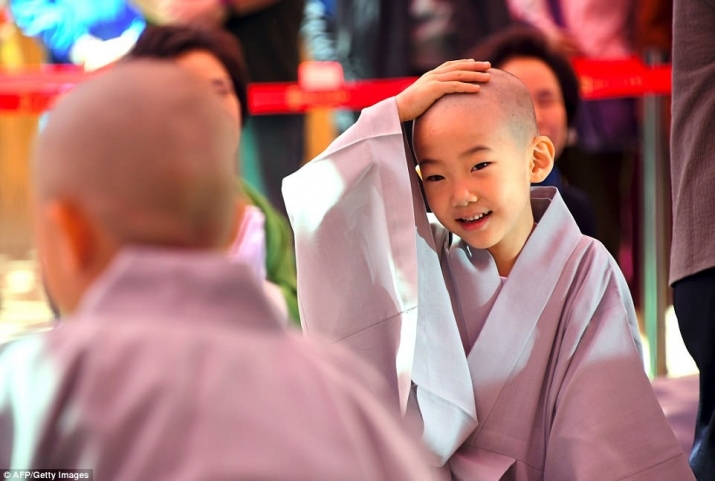 A boy smiles while touching his bald head. From mailonline.com
A boy smiles while touching his bald head. From mailonline.comThe boy monks will spend two weeks at Jogyesa until 3 May—the Buddha’s birthday—where they will learn about the Buddha’s teachings.
The Buddha’s birthday is also known as Seokga tansinil, or Bucheonim osin nal (the day the Buddha came) in Korea. Although the exact date of birth the Buddha’s birth some 2,500 years ago is unknown, Korean Buddhists celebrate his coming on the eighth day of the fourth month of the lunar calendar (between late April and mid-May), which this year falls on 3 May.
Jogyesa, the most important temple for South Korea’s 10.7 million Seon Buddhists, is at the center of the Seokga tansinil or Bucheonim osin nal celebrations. Buddhism is the second-largest religion in South Korea, after Christianity, and although only 23 per cent of South Koreans identify as Buddhists, the Buddha’s birthday is a national holiday observed throughout the country.
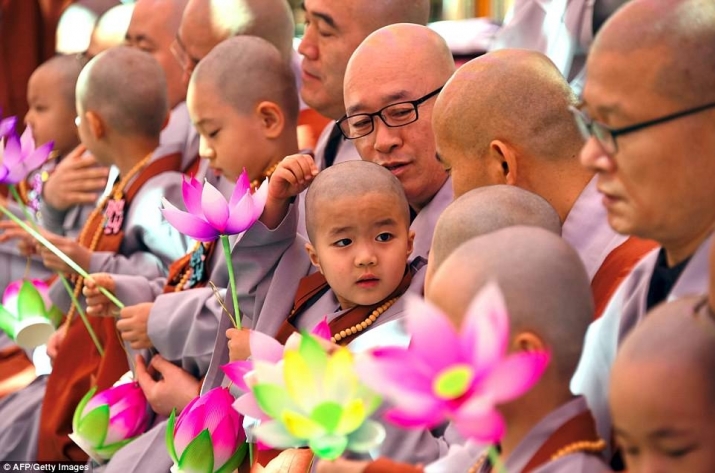 The boy monks and their teachers. From mailonline.com
The boy monks and their teachers. From mailonline.comPeople celebrate Seokga tansinil by lighting colorful lanterns and holding lantern parades at night. The largest such parade can be found in Seoul, passing by the brightly lit and colorfully decorated Jogye temple. For the duration of the festival, temples open their doors and offer food and drinks for all those who visit. During breakfast and lunch, the temples usually serve a traditional dish of rice mixed with fresh vegetables known as bibimbab.
The boy monks, nicknamed “baby Buddhas,” and “mischievous Buddhas” by Ven. Jaseung, the president of the Jogye Order of Korean Buddhism, will participate in the Lotus Lantern Festival (Korea’s National Intangible Cultural Property No. 122), to boost the festive atmosphere and serve as ambassadors, aiming to make Buddhism accessible for all those who come to visit.
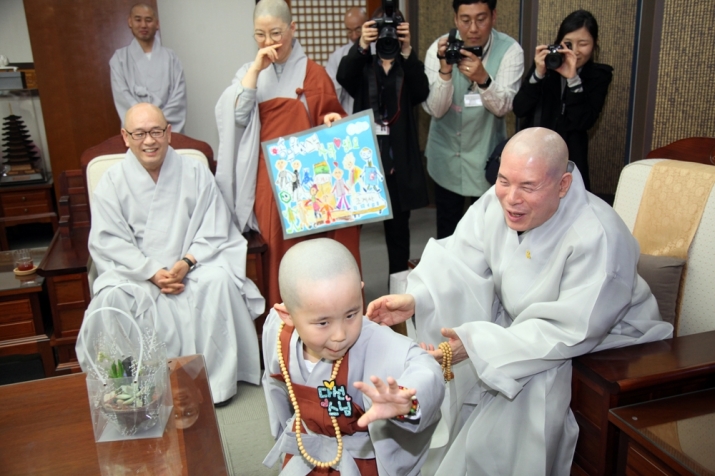 Ven. Jaseung nicknamed the boy monks “baby Buddhas,” and “mischievous Buddhas.” From ibulgyo.com
Ven. Jaseung nicknamed the boy monks “baby Buddhas,” and “mischievous Buddhas.” From ibulgyo.com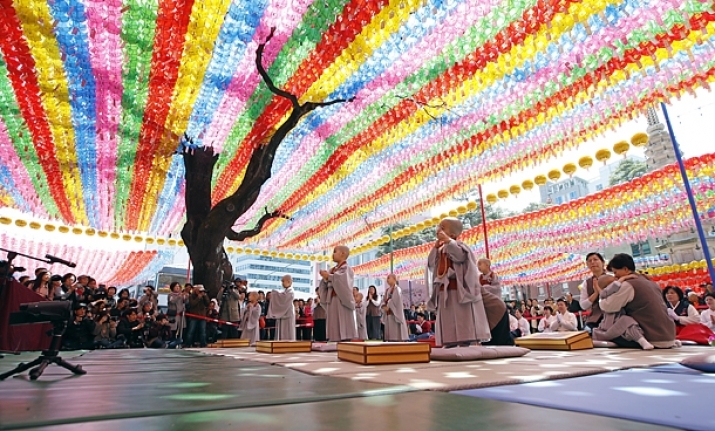 The boy monks underneath the traditional sea of colorful lanterns at Jogyesa. From koreajoongangdaily.come
The boy monks underneath the traditional sea of colorful lanterns at Jogyesa. From koreajoongangdaily.comeRead more:
Jogyesa’s Newest and Littlest Monks Met Ven. Jaseung, the President of the Jogye Order of Korean Buddhism (Jogye Order of Korean Buddhism)
Religion in Korea (Korea.net)
Sparks of wisdom (Korea Joongang Daily)
Seoul’s Jogyesa Buddhist Temple Welcomes Its Newest (And Littlest) Monks (Huffington Post)
I'm having a bad prayer day: Children undergo traditional Buddhist head-shaving in South Korea (Mail Online)

